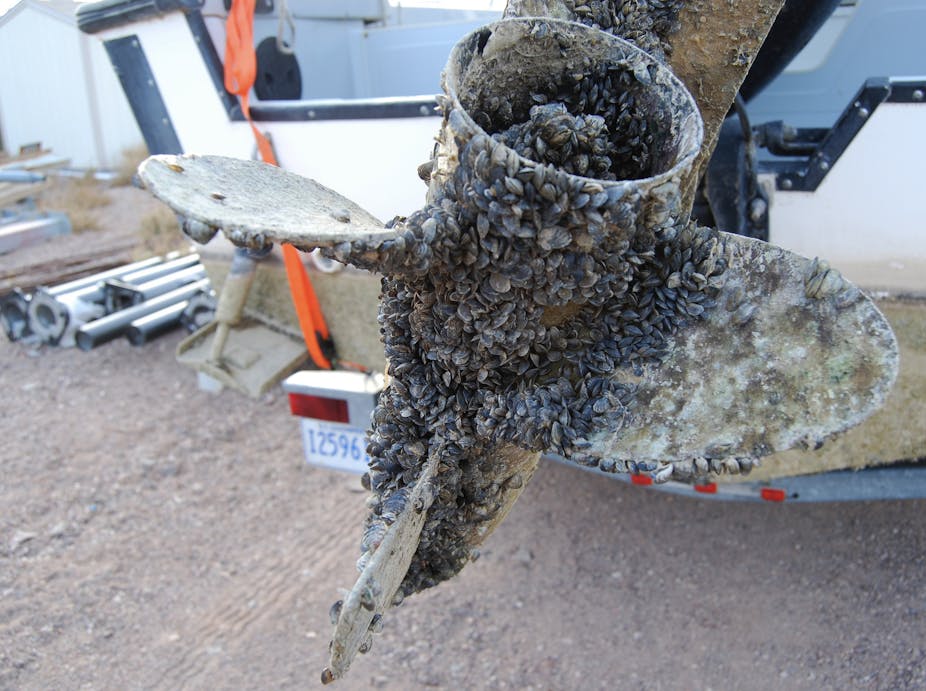The UK’s environment agency has confirmed quagga mussels, a fresh or brackish water mollusc, have been found in a reservoir near London.
Quagga were previously identified as one of the single greatest threats to UK wildlife, yet also one predicted to be highly likely to invade UK waters.
Originally found in the Dnieper River in Ukraine, these thumbnail-sized mussels have since invaded freshwater systems across the world, particularly in North America. Quagga form a dense mat of shells on river, lake and reservoir floors, taking up space that might be otherwise used by native species. They are big zooplankton eaters, which has a knock-on effect on the abundance and structure of food available to native fish.

Quagga arrive in the UK with a costly reputation. Together with their close relative the Zebra mussel, they are known for clogging pipes, reducing water quality and fouling boats. In the Great Lakes, quagga now blanket the bottom of Lakes Michigan and Huron, depriving creatures further up the food chain of vital nutrients. Lake Huron, once a fishing paradise, saw its salmon population crash after quagga took over and began competing with the smaller fish that salmon feed on. Even the Hoover Dam on the Colorado River has had to temporarily shut its turbines in order to clear out the mussels.
Experience teaches us it is highly unlikely we can eradicate these species. But we have also learnt that there are many things we can do to reduce their effects and spread.
Much of the reason that eradication of quagga mussel is unlikely is due to scale. If we have found them in one place they are likely to be in others. Scientists dealing with the early invasion of the zebra mussel in the Great Lakes of the US and Canada confirmed that eradication was unlikely once they realised the new population had already spawned several times before detection.
However, the Great Lakes are a huge interconnected waterbody and Britain has nothing of comparable size; there’s no need to give up just yet. If the UK has an opportunity to eradicate this current mussel invasion then action must be immediate and drastic. Given the scale of the eco-economic burden the quagga will bring once established, it is entirely reasonable to think outside our normal set of tools and apply extreme methods.
Man vs mussel
There are emerging direct methods to try to kill off invasive mussels. In North America poisonous fertiliser and a new bacterial product are being trialled this year against zebra mussels. But some indirect methods may also work.
In Scandinavia acid rain, caused by air pollution, and changes in soil chemistry following uplift have caused some coastal lakes to turn acidic, wiping out native mussel populations. Acute decreases in water pH as a management action will cause massive short term change in the biology of the invaded lakes. Fish become less fertile, some species may become extinct, and the makeup of local invertebrates and zooplankton will change. However it is possible that in low-pH water the quagga (and all other molluscs) will become locally extinct due to the effect of the acid on their shells. It’s a long shot.
A second, perhaps more palatable, option is to manage fish populations to maximise their negative effects on quagga. The normal way to harvest fish involves taking only the largest fish down to some minimum size. An alternative idea is to remove those medium sized fish which prevent young fish from thriving, increasing their numbers so they can compete with and consume quagga. These are all untested ideas, but are based on observations of natural ecological dynamics (that is, acidification leading to extinction and competition leading to population decline).

We largely know what causes the spread of non-native invasive aquatic species once they have arrived at our ports in the ballast of shipping vessels. Larvae have been found to hitch rides between lakes and rivers in fishing equipment – waders and fishing reels being particularly vulnerable – on boats and other water sports equipment.
It is vital that the UK authorities provide advice and equipment for recreational lake and river users in the south of England to wash their equipment as soon as they have finished at each site, and certainly before they switch to a new site.
The realists will state clearly, and probably correctly, that the quagga is here to stay. Or at least that if such extreme measures for eradication above did work then it would only be a temporary measure until another invasion occurs, or another population that is already here is discovered. But given the huge economic cost of a full-scale quagga invasion, it would be better to have tried and failed than not to have tried at all.

